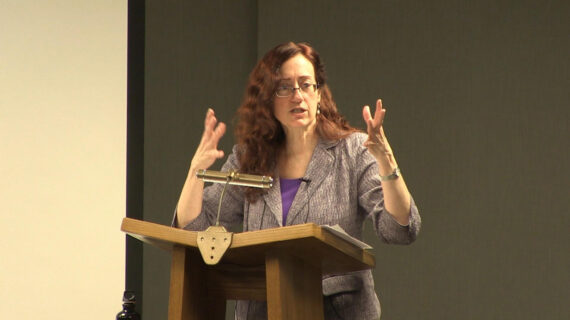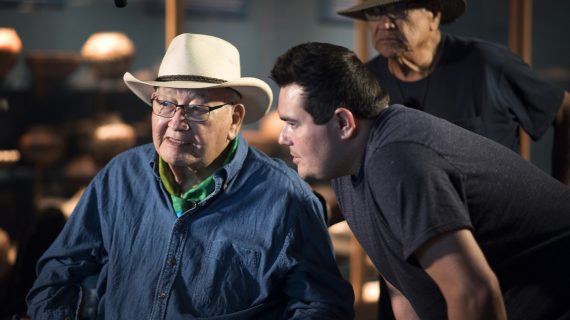[Laura Heisler, Director of Programming, Wisconsin Alumni Research Foundation]
It is my pleasure to present Professor Susan Lederer, who is the Robert Turell professor of the History of Medicine and Bioethics at U.W. Medicine in the School of Medicine and Public Health. She is a historian of medicine and biomedical ethics and has published on the history of both human and animal experimentation. Her books include Subjected to Science, Human Experimentation in America Before the Second World War, Frankenstein: Penetrating the Secrets of Nature, and Flesh and Blood: A Cultural History of Transplantation and Transfusion in 20th Century America. She’s currently working with Professor Susan Lawrence on a history of full body and organ donation in America. Please join me in welcoming Professor Susan Lederer.
[Susan Lederer, Professor, Medical History and Bioethics, University of Wisconsin School of Medicine and Public Health]
Good evening.
I sometimes think I’d like to talk about Frankenstein when it’s dark and stormy, but I’m really glad that it’s light and not stormy this evening. Although I have to confess, the pollen has – has influenced my – my voice. So, luckily there is water.
So, the occasion for this talk – is an anniversary. It is the 200th anniversary of the publication of a work of fiction that has had an enduring and compelling influence on western culture.
[slide featuring the title page of the novel Frankenstein, or the Modern Prometheus by Mary Shelley]
The book is “Frankenstein” or “The Modern Prometheus.” And this is the original title page for the 1818 edition.
I hope that many of you have read the book. But I know that even if you have never read Mary Shelley’s 1818 novel about a pale student of unhallowed arts who secretly animates a creature –
[Susan Lederer]
– you know who Frankenstein is. You’ve heard of Frankenstein. I would be astounded that you’ve never heard of Frankenstein.
And you may also know –
[slide featuring a portrait painting of Mary Shelley [1797-1851])
– there’s Mary Shelley. You perhaps also know that in Mary Shelley’s story, Frankenstein actually refers to the young man. He’s actually a college dropout, named Victor Frankenstein.
[Susan Lederer]
And it’s Victor who visits the graveyards and the slaughterhouses for the raw materials that he will use in his creation.
The creature, the monster, and he has a number of names that Mary Shelley characterizes him as, the mummy, the abortion, the misbegotten. The monster has no name. And indeed, that’s part of the tragic nature of the book. Victor Frankenstein creates this being and then fails not only to give it a name, but to aid his Adam.
And in the 200 years since Mary Shelley first breathed life into her tale, Frankenstein has come to refer to both the monster and his maker, the monster and the man, who have become inextricably linked in our literature, in our mythology, and also in our vocabulary, particularly when it comes to talking about concerns in biomedical advances and their implications for human society.
[slide featuring the 1831 frontispiece illustration of Dr. Frankenstein and his monster]
So, this is just from the 1831 frontispiece. This is the first depiction of the monster sort of in print in that particular version.
So, you know about Frankenstein. And you may also –
[Susan Lederer]
– but you perhaps know less. I might be surprised if you knew much more, about head transplants. And you may even wonder what is the link between Frankenstein and the head transplants? Let me just tell you right now there is one. That’s the subject of the talk tonight. But let me first assure you, reassure you perhaps, that head transplants are in fact a real thing. They are not a gothic fiction –
[slide featuring the one sheet from the 1962 film The Brain That Wouldnt Die along with a photo from the film of a womans head on a tray with a doctor beside her]
– nor a Hollywood horror story, like this 1962 film, The Brain That Would Not Die. Although it’s actually the whole head, apparently, that could – would not die. I have to admit I’ve never seen this film. But – but you can guess sort of the – the plot.
[Susan Lederer]
Now it’s true that a human head transplant has yet to be successfully performed. But it’s not for lack of ambition on the part of these two men –
[slide featuring a photo of the Italian surgeon Sergio Canavero and his Chinese collaborator Xiao-Ping Ren together in their scrubs]
– Italian surgeon Sergio Canavero and his Chinese collaborator Xiao-Ping Ren.
Since 2013, and also in a now famous TED Talk –
[new slide with a screenshot of Sergio Canaveros TED talk in Verona featuring Sergio on stage with a photo of Frankensteins monster from the Universal film above him on a projection screen]
– in which he used the picture of Frankenstein, Dr. Canavero has been announcing the imminent performance of a human head transplant. But like many imminent things, its arrival keeps getting pushed back. But he keeps claiming it’s going to happen any day.
And in the last five years, Dr. Canavero has talked a great deal about the prospect of such surgery.
In so doing, he has claimed that Mary Shelley’s 200-year-old novel directly inspired him. I guess hence, Boris Karloff.
[Susan Lederer]
Not only does the book reveal a missing piece, he claims, to his plan to replace the head of a human being, it also provided the justification for such experimentation. Just as the fictional Victor Frankenstein discovers how to re – how to animate lifeless tissue, Canavero claims that his intention with human head transplants is to cheat death. I mean, that’s an ambition.
And he’s also predicted a future in which even healthy people could opt for a full body transplant as a way to live longer, eventually putting heads on their own cloned body. So, he’s also sort of imagining this as a future trajectory.
I’m into life extension. This neurosurgeon has repeatedly informed reporters. Life extension and reaching the wall between life and death. And I will say that he has courted the media very –
[slide featuring a publicity photo of Dr. Canavero standing in front of a decapitated head on a tray and a screenshot of Dr. Canavero doing a interview with I.T.V.]
– claiming that again, Frankenstein – He’s – hes done this both in his published scientific papers and also in his discussions with reporters. But he’s also posed for pictures and given lots of talks to reporters. And he’s actually – he’s doing this, he says, because he’s attempting to crowdfund what he estimates to be –
[Susan Lederer]
– a $100 million surgery to perform the first human heart trans – excuse me, head transplant. And because he can’t get money from the usual sources. So, he’s looking toward – to, you know, the public to help support this.
Well, like Victor Frankenstein and his creature, Canavero has actually melded with the surgical procedure he has so boldly proposed. In both the popular and scholarly press, the surgical procedure in which a diseased and badly injured body is replaced with a healthy one has been labeled –
[slide featuring a photo of Dr. Canavero from Discovery magazine superimposed with the quote Italian Neurosurgeon Sergio Canavero is planning to conduct Frankenstein experiment to reanimate human corpses to test his technique – next to the photo is a list of what these proposed experiments have been called including Frankenstein surgery, Operation Frankenstein, and Frankenstein experiments]
– Frankenstein surgery. It’s been called Operation Frankenstein. Its, you know, there’s been reference to Frankenstein experiments. And perhaps not surprisingly, Canavero is referred to as The Brain behind the Frankenstein surgery of the human heart – or the head transplant.
[Susan Lederer]
Now Canavero has claimed, again, I mean, in – in numerous forums to have been inspired by Mary Shelleys novel. But it’s not clear if hes in fact read the book. Or actually appreciated, if he has read it, what Shelley was actually trying to communicate some two centuries ago, and in a message, I think that continues to have relevance for us today. But Canavero certainly does recognize the cultural power of Frankenstein, again, the monster and the maker. And he’s attempted to harness that power for his own purposes as he attempts to become a 21st century Prometheus.
So, let me just explain what I want to do tonight, which is to briefly sketch out Mary Shelleys concept, or conception of Victor Frankenstein and his plan to collapse the boundaries between life and death.
And I will then give you some examples – some examples of the ways in which the Frankenstein myth and the Frankenstein metaphor have provided a – a very ready means to articulate anxieties about a range of biomedical advances. And this from, you know, the – the last third of the 19th century, you know, to the present time.
And finally, at the end I will return to Dr. Canavero and Dr. Ren to their proposed surgical intervention and their efforts to rehabilitate Frankenstein in the case of the human head transplant. So – so, that’s my plan.
So, let me turn now to the genesis of – of Frankenstein.
Well, some of you may know that Mary Shelley’s story began with a contest.
During the very uncongenial and rainy summer –
[slide titled The Summer of 1816 featuring a painting of the Swiss home on Lake Geneva that was visited that summer by Mary Shelley, Percy Shelley, Lord Byron, and John William Polidori. The slide also includes painting portraitures of all four of the above named]
– of 1816, Mary Godwin, as she was then, and her lover, the poet Percy Shelley, ran off to Switzerland. There, on the shores of Lake Geneva, the couple visited often with the poet Lord Byron and his physician John William Polidori.
They spent evenings reading aloud German stories, a fantasy in supernatural events. And it was at Byrons suggestion that they each agreed to a story competition.
[Susan Lederer]
Each of them would come up with their own tale of a supernatural occurrence.
Mary Godwin was just 18 years old, but she took the task very seriously and – and worked to – to bring the story to – to fruition.
So, she worked on her manuscript for two years. Percy Shelley took quite an interest in her writing. He made over 1,000 suggestions and changes to her manuscript and actually wrote the original preface for Frankenstein as it appeared in the 1818 edition.
By the time the book appeared in 1818, Mary Godwin had married Percy Shelley. She was mother of several young children. She was just 20 years old.
Now Mary Shelley’s name did not appear in the book or on – on the title page. Although published anonymously, the book did have a dedication. She chose to dedicate the novel to the philosopher William Godwin. A radical political thinker, Godwin also happened to be Mary Shelley’s father. And it was an effort to – to gain or to – to come back into his good graces.
But the dedication to Godwin, his radical, political views, excited great speculation about who had written this strange novel. Some people thought it was the work of Percy Shelley, who was associated in the public sphere with William Godwin and his ideas. No one seemed to think that it could have been the work of Mary Shelley, despite her impressive literary lineage.
She was not only the daughter of William Godwin, the philosopher, but her mother –
[slide titled, Mary Wollstonecraft, featuring a photo of the book cover of the Penguin Classics edition of A Vindication of the Rights of Woman by Mary Wollstonecraft]
– was the formidable author Mary Wollstonecraft, a radical philosopher in her own right, and the author in 1792 of “A Vindication of the Rights of Woman.”
[Susan Lederer]
Now – so, the original novel was published in 1818 without Mary Shelley’s name on it. Her name appears, you know, when she – in a new and revised edition of “Frankenstein”, is published in 1831. And actually, Mary Shelley has the opportunity to write her own preface to the novel.
And in so doing, you know, she – she discusses, or she explains how she had been so frequently asked about how she as a young girl had come to think of and to write about such a hideous idea that she wanted to give an explanation for it.
And her explanation was that she recalled long conversations in which she was a silent listener, a conversation between Byron and Shelley about the nature of the principle of life, about the possibility that it could be discovered, it could be harnessed, it could be manipulated for the good of mankind. And as she wrote in the 1831 preface –
[slide featuring a photo of the 1831 Edition of Frankenstein and the below quote from Mary Shelley in her preface]
– “Perhaps a corpse would be re-animated; galvanism had given some token of such things; perhaps the component parts of a creature might be manufactured, brought together, endued with some vital warmth.”
And I would argue that part of Mary Shelley’s genius in fashioning the story of Victor Frankenstein and his creature –
[Susan Lederer]
– was her ability to draw on the natural philosophy, the medicine, natural history of her day, which she had experienced through her own program of extensive reading, which again set her apart from most of – of the young women of her time, or through meeting, through her father and his publication, of many of the most eminent scientists and physicians of her day.
Now in the early 19th century, the boundary between life and death intrigued physicians and other students of nature. There was, for example, considerable excitement and interest in the possibility that one could resuscitate the near or newly dead.
Beginning in the 1760s, what were then called humane societies, were organized by both physicians and reformers who sought to teach methods on how to revive people who might have been drowned or suffocated or had even, you know, gone on to death itself.
First organized in 1774, the Royal Humane Society in 1796 –
[slide featuring an illustrated poster put out by the Royal Humane Society showing a downed man being retrieved from a lake]
– boasted of having revived more than 2,000 people through various methods. This is actually some of their propaganda, you know, showing the sort of the discovery of a young man sort of apparently drowned in the lake –
[new slide featuring another propaganda illustration by the Royal Humane Society showing the once drowned man recovering in a bed as his wife, children and doctors look on]
– but methods of resuscitation were – were applied to him. And then you see him happily restored to the bosom of his family.
Also, among those revived –
[Susan Lederer]
– was in fact Mary Shelley’s own mother, Mary Wollstonecraft. Mary Wollstonecraft actually set out to commit suicide in 1795 following an unhappy love affair. In a letter that was written shortly before her attempted suicide, she expressed the hope that her body would not be in – be insulted by being snatched from death by people like this. She actually jumped into the Thames. She lost consciousness but was then rescued by some watermen. And in a letter that was written after her successful revival, she expressed not gratitude, but actually resentment that she had been revived. She wrote, “I have only to lament that when the bitterness of death was passed, I was inhumanely brought back to life and to misery.”
Now in addition to sort of these physical methods of resuscitation, the application of smelling salts, you know, putting – using a bellows to breathe air into the lungs, the direct application of electricity, or galvanism, to revive the dead also generated intense excitement among physicians and the public.
In the 1790s, the Italian anatomist Luigi Galvani performed an extensive set of experiments in which he applied sort of an electrical current to the dissected muscles of a dead frog, thereby producing movement. So again, sort of interest in the possibility that you could discover the spark of life, and that again this could be harnessed and manipulated was a Promethean dream of the time.
Galvani’s nephew, Giovanni Aldini, actually took his uncle’s work to the public. He conducted extraordinary public demonstrations throughout Europe and throughout the continent and also in the United Kingdom in which he would apply electrical current –
[slides featuring two illustrations of Giovanni Aldini’s scientific work, one an illustration of how to apply electrical current to the heads of decapitated cows and a second illustration showing scientists applying electrical currents to decapitated human bodies]
– to the ears and noses of newly decapitated animals. This is from an 1803 engraving in his book “Among Galvanism”, showing the application of electrical current, you know, to the head of an ox.
And also, he would apply electrical current to the bodies of decapitated human beings.
For example, in 1803 –
[Susan Lederer]
– Aldini visited London and held public demonstrations that were attended by the Prince and Princess of Wales, among others. He applied current not only to dead animals, but to recently executed criminals from London’s Newgate Prison.
[slide featuring two color illustrations of scientists attaching electric current, one to decapitated bodies and the other to a decapitated head]
After applying the electrical current to the muscles of the face, I have a closeup, the muscles of the face, reportedly the jaw began to quiver. The adjoining muscles were horribly contorted in the face. And in one eye, actually opened.
[Susan Lederer]
And this was a sensation.
Now Mary Shelley drew on the science of her day to create the story of Frankenstein. But I would submit sort of the science wasn’t her primary aim. In so doing, she was especially interested in the creator’s responsibility in using these godlike powers of reanimation and resuscitation.
In the novel, Victor Frankenstein, you know, has these powers. He’s been appalled at the outcome of his experiment and abandons his creature. And again, it’s this creature’s profound alienation from all of human society, his intense loneliness, his abject isolation from all human contact, the rejection by his own creator that leads him to mayhem and murder and sort of the ensuing tragedy that fills the pages of the book.
So, let me turn now to the use of Frankenstein as metaphor.
Mary Shelley’s depiction of a creator, who despite his best intentions, and I think Victor does have very good intentions in the novel, but instead makes a monster, quickly becomes part of the cultural vocabulary.
And in fact, for three decades of the 19th century, “Frankenstein” was actually the most popular novel in the English language. Translated into at least 29 other languages, the novel, you know, I think it’s something of a record, has been in print continuously for some 200 years.
But the Frankenstein story, as opposed to the novel, also became both more and less of Mary Shelley’s creation.
In the stage adaptations that were quickly made after the publication and popularity of the novel in 1818, the Frankenstein story was dramatically streamlined, not surprisingly, perhaps, to condense, you know, a several hundred-page novel to, you know, an hour-and-a-half stage adaptation. But it was also dramatically simplified.
I’ve suggested elsewhere, but I – I do think it’s true, that the popular culture version of Frankenstein can be reduced to actually two simple sentences.
“It’s alive!” And the more ominous, “it’s escaped!”
And it was in this form that the Frankenstein story actually reached, you know, sort of a broader and more diverse audience again in Europe, in England, and in the United States. And perhaps not surprisingly, it also became a recognizable metaphor in both political discourse and in political cartoons. It came to symbolize, or to manifest people and things that were out of control, that were monstrous. And I think one of the best examples of this –
[slide featuring two illustrations from the British magazine Punch, both portraying Ireland as Frankenstein’s monster to Britain’s well-behaved gentlemen]
– is from the British magazine “Punch”. These are English men being menaced by the Irish Frankenstein, who are freakish, violent, out-of-control, an example of power that has been misused and now threatens the good of the English – the English nation.
Now in the American context, the Frankenstein metaphor began to appear in discussion of medical developments in the 1870s. And this comes from a story that appeared in a San Francisco newspaper –
[slide titled, Daily Alta California, October 1871, featuring a photo of an article titled Nice Surgical Operation]
– the “Daily Alta California” in October 1871. It’s a front-page story that talks about a “Nice Surgical Operation.” But the operation was hardly nice in the conventional sense. The, you know, the article –
[new slide titled, Nice Surgical Operation, featuring a close up of the first line of the article which is quoted below]
– goes on to say, “Mrs. Shelley’s fearful creation, Frankenstein, will presently take its place among the possibilities if science and surgery continue to advance.”
[Susan Lederer]
And it goes on to describe the surgical skills of an Illinois physician who takes pity on a young woman whose face has been horribly deformed by a cancerous growth, which renders her an object of loathsome horror. Working with a dentist, he implants new teeth. He creates a new jaw for her. He applies some of the new techniques that were developing in surgery involving the grafting of skin.
This shows sort of skin grafting, sort of, you know, taking skin harvested from the body in an effort to repair grievous injury. And I am – this is not – I don’t know particularly the kind of cancer she had. But again, showing sort of what, you know, an effort to make whole someone who had been rendered an object of loathsome horror because of their appearance.
Now Frankenstein metaphors were useful not only to reporters but also to physicians themselves. And in the 1880s, for example, discussion in the obstetrics literature, in both England and in the United States, referenced Frankenstein when describing the necessity for caution in using ergot on pregnant women. It was – it was a drug that was used to stimulate uterine contractions.
Sorry, further ahead than – than I wanted to.
But again, the point that they were making was, you know, that the incautious use of this drug arouses a Frankenstein whose brute force we are unable to control. We prefer to use an instrument which is under the control of hand and head, which we presume to supplement the force of nature.
Now in the 20th century, the medicalization of Frankenstein intensified after the enormous success –
[slide titled, 1931, featuring a photo of Boris Karloff as Frankenstein’s monster and the credit title screen from the movie showing a question mark as to who is playing the Monster]
– of the 1931 film featuring Boris Karloff. Although, I put this up just to show you, he doesn’t actually get credited for his – his performance. It’s sort of the Monster as question mark. And this film did have an enormous impact.
[Susan Lederer]
And just as Mary Shelley had drawn on contemporary developments in galvanism and resuscitation in creating her original monster, the Universal filmmakers –
[slide featuring a magazine article from the 1930s titled, Can Science Raise the Dead?]
– drew on intense interest in the 1930s to achieve immortality through organ transplants and artificial organs.
And one scientist who generated enormous interest in the 1930s was a chemist –
[new slide featuring photo of the chemist Robert Cornish in his lab with the dog Lazarus IV and the quote “The fear that such experimentation on a human being would evolve a fiendish Frankenstein monster.”]
– at the University of California named Robert Cornish who successfully revived dogs that he’d actually killed with cyanide gas. In 1934, Cornish was in hundreds of newspapers around the United States when he claimed to have successfully reanimated Lazarus IV, shown here. And he’s quiet about Lazarus I, II, III. Nonetheless, he’s successful here. And again, I think somewhat like Canavero, Cornish had something of a genius for self-promotion and publicity and naming the dogs Lazarus was – was just the tip of that iceberg.
[Susan Lederer]
But the successful revival of dogs like Lazarus was marred by a concern that their reanimation had somehow altered in a profound way the animal’s mental state. And in newspapers, you know, reporters would say the fear that such experimentation on a human being would evolve a fiendish Frankenstein monster. And in fact, there’s no record that Cornish was ever able to attempt his reanimation technique on human beings, but not for want of volunteers. He received hundreds of letters from people around the country volunteering to be killed by cyanide gas and then revived. I can’t explain it, but I’ve seen – I’ve seen the letters.
And he actually did go to the governors of several western states which had just introduced the gas chamber. And he asked for permission to attempt to revive them once they’d been successfully executed. But this excited all kinds of newspaper speculation about “what would their legal status be?” Would that mean if they were revived, they were free to go out, you know, and be on, you know, be free of prison? Or would they have to go back to prison? And again, there was this concern that once you’re revived from the dead, you’re never quite the same.
Now the most sustained use, however, of the Frankenstein story came in – in the late 20th century. It occurs in the context of the advances in genetics in the 1970s.
In the summer of 1976, as campuses across the country debated the safety and the wisdom of using the newly developed recombinant D.N.A. techniques, the mayor of Cambridge, Massachusetts, for example, voiced very strident opposition to allowing Harvard laboratories to engage in this research.
“We want to be damn sure,” he told reporters, “that the people of Cambridge won’t be affected by anything that could crawl out of the laboratory. They may come up with a disease that cannot be cured. Is this the answer to Dr. Frankenstein’s dream?”
[slide featuring an illustration of an editorial cartoon from the 1970s with a caricature of Dr. Frankenstein labelled M.I.T. carrying a newspaper with the headline – Cambridge Okays Genetic Research – and the caption Crack out the Liquid Nitrogen Dumplings, We’re on Our Way]
And – and here you can see sort of Frankenstein lurking, but there are other kinds of monsters. In this audience, some of you may recognize what’s coming out of that one particular bauble. So again, this occurs in the context of genetic research and also, not surprisingly, in sort of –
[new slide featuring a photo of the Time magazine that featured the photos of Dolly the sheep and her clone with the title – Will There Ever Be Another You? – with a quote of – a major outbreak of the Frankenstein syndrome]
– cloning research that occurs in the 1990s. Perhaps not surprisingly when the Scottish researcher Ian Wilmot announced the successful cloning of Dolly in 1997, the Frankenstein myth received renewed attention. You know, one reporter called it “a – a major outbreak of the Frankenstein syndrome.” That was the most immediate consequence of the cloning of this Scottish sheep. And again –
[Susan Lederer]
– what she meant by this was invoking fears of a force of evil unleashed by science onto an unsuspecting and unprotected public.
In the 1990s, the invocations of Frankenstein, which articulated ambivalence and anxiety about developments in biomedical science, were so widely recognized that they could be signaled by the prefix Franken.
[slide titled, Franken -, with its definition – to brand something unnatural, often with its origins in the laboratory – below]
And I’ll, you know, again – sort of Franken as a prefix to brand something unnatural, with its origins in the laboratory.
[new slide noting the first reference of Franken- to Frankenfood in 1992]
I traced the earliest use to 1992 in that, you know, in someone describing Frankenfoods.
[Susan Lederer]
The reporter from the “New York Times” who says, talking about genetically-modified foods, “Ever since Mary Shelley’s baron rolled his improved human out of the lab, scientists have – have been bringing just such good things to life. If they want to sell us Frankenfood, perhaps it’s time to gather the villagers, light some torches, and head to the castle.”
And, you know, this is just one specimen –
[slide featuring an illustration of Kelloggs Genetically Modified Frosted Fakes by Greenpeace with Tony the Tiger portrayed as Frankensteins monster holding a test tube of an unidentifiable substance]
– of the – of the – of the power of the Franken prefix, you know, as deployed by Greenpeace, sort of genetically modified Frosted Fakes, you know, Frankenfood, bad. Kids get your own gene splicer, you know –
[new slide featuring another illustration from Greenpeace titled IT Came From the Grocery Store featuring a 1940s woman reeling in terror and a mad scientist in the lower left-hand corner]
– or this, “IT Came from the Grocery Store.” You know, it’s not labeled, the horror of genetically modified. And then, you know, sort of scientist at his, you know, in his laboratory.
[new slide featuring two more illustrations, one from a weekly magazine extolling an article on Frankenfood on page 8, and a poster of Frankenfood on Parade an anti-G.M.O. gathering whose poster features a cross between an ear of corn and a crab leading a line of genetically modified fruit]
And you know, you’ve seen these genetically, you know, Frankenfoods. Oh, excuse me, “Franken- Frankenfood on Parade.” You can also see –
[new slide featuring an illustration from the London Times of a cow with the head of Frankensteins monster titled Frankencow]
– “Frankencow.” It – it morphs into
[new slide titled Frankenvirus showing an electron microscope image of a polio pathogen created by scientists]
– “Frankenvirus,” when you can build a “polio pathogen from – from scratch.” Sort of, I don’t know if people recall the –
[new slide featuring a newspaper article about the Frankenfish]
– Frankenfish scare, you know, the fish that walks on land from pond to pond. I don’t have a slide for this –
[Susan Lederer]
– but I was interested how, in a Manhattan courtroom in 2003, you know, a judge invoked the specter of Vic Frankenstein chicken nuggets. Now this – it was in a lawsuit that was actually brought against McDonalds, which held the chain liable for obesity and other illnesses in unsuspecting young people. The judge actually threw out the lawsuit, but in so doing, he labeled Chicken McNuggets quote, a McFrankenstein creation of various elements, not utilized by the home cook. So, an unnatural thing to be sure.
And now I submit you don’t even need Franken, because you recognize –
[slide featuring an apple with a scar at the top and two bolts on the bottom]
– the iconographic elements of a Frankenfood, you know, the scar, the, you know, the bolts. And sort of – I – I –
[new slide of a Gary Larson cartoon with a flower strapped to a wooden plank with one scientist about to apply a syringe and hypodermic needle and another scientist holding a clip board with the caption – Botanists create the first artificial flower]
– love this cartoon by Gary Larsen, because you don’t even need to mention sort of the Franken, but you know that this flower is an unnatural creation, right, trying to escape from the laboratory.
Now G.M.O.s and foods –
[new slide featuring two photos, one of a Frankensteins monster life-size art piece with a sign that says – Genetically Engineered Foods, Kid Tested NOT Mom Approved, and one of the cover of a book titled, Pandoras Picnic Basket – The Potential and Hazards of Genetically Modified Foods]
– produce the most sustained invocations of Frankenstein, with a few alternatives. Frankenstein, I would submit, had much more power as a metaphor than Pandora, and in this case her picnic basket. And Farmaggeddon also didn’t seem to catch on.
But Frankenstein, you know –
[new slide titled, The Hubris of Dr. Frankenstein and Reproductive Cloning, and featuring two editorial cartoons with Frankensteins monster represented as Human Cloning]
– frames for ongoing critiques of biomedicine continued, you know, in human cloning, you know, in – in 2001, you know, sort of cartoons like these. So, what’s the big deal, what could go wrong? You’re alive, those sort of hubris, reproductive cloning.
[Susan Lederer]
Also, I mean – and sort of when it comes to – it provides a framework for talking about medical inter – and surgical interventions that are seen as unnatural. So, in – in this case, in the treatment of Ashley X, this was a young girl in Seattle who had a developmental brain condition known as static encephalopathy. Her parents in, I think a good faith effort – effort to keep her at home, sought medical help to keep her small and not to have her develop sort of reproductively.
And – but when this, you know, sort of came to public attention, you know, there was a lot of criticism. And in particular, some critics charged that the Ashley treatment was creating a 21st Franken – a 21st century Frankenstein, you know, that involved maiming a child as a sake of, you know, for the sake of convenience of her parents, who are also her most dedicated caregivers.
And, you know, particularly, you know, and finally I’ll get to –
[slide titled, Human Head Transplants, featuring two LEGO nurses and a LEGO doctor in front of a LEGO man whose head is about to be reattached to his LEGO body]
– human head transplants, shown here sort of in the LEGO form.
Now currently, neurosurgeons –
[Susan Lederer]
– Sergio Canavero and Xiao-Peng Ren are generating the most attention with again their most highly publicized plans to go forward with a human head transplant. So, as I mentioned at – at the outset, Canavero first announced his plan in 2013. His idea, which again I think was well-intentioned, to extend the lives of people whose bodies were degenerating through, you know, horrible, you know, degenerative disease, or, you know, from fearful injury.
But I point out, although, you know, that the idea of head transplants seems outlandish, it’s certainly not new. And so, for more than a century, scientists, physicians have been attempting to perform head transplants in the first half of the 20th century, actually for the, you know, for the entire 20th century, not on human beings, but on animals.
In 1908, for example, the American physiologist Charles Guthrie, grafted a dog’s head onto another dog’s neck, showing, you know, that blood could flow into the decapitated head.
In the 1950s, the Russian researcher Vladimir Demikhov, who was a pioneer in both human heart –
[slide titled, Vladimir Demikhov LIFE Magazine 1959, featuring a photo of Mr. Demikhov working with dogs]
– and lung transplants, grafted the upper bodies of young dogs onto the shoulders of – of other dogs, creating dogs with two heads, and demonstrating that both were able to move and see. And they even apparently drank water. These – these are images that appeared in LIFE magazine in 1959, although these were experiments that were not –
[Susan Lederer]
– without criticism at the time, even from some surgeons who couldnt see what value this might be, what demonstration of this would produce.
In 1965, the Cleveland surgeon Robert White transplanted the brains of six dogs onto the necks of other dogs in order to demonstrate that the brains could be kept alive in another body.
In the 1970s –
[slide titled, Robert White, M.D., featuring a publicity photo of Dr. White along with two illustrations of his work with Rhesus monkeys]
– he actually transplanted the entire head of a Rhesus monkey onto another monkey’s body. The monkey could reportedly see, hear, and taste. In this particular transplant, he didn’t attempt to fuse the spinal cord. The monkey lived for several days, although there seems to be some, you know, uncertainty about just how long the monkey lived following the surgery.
[Susan Lederer]
But White believed that his successful experiment established the inevitability of head transplants. Actually, writing in Scientific American in 1999, he forecast what has always been the stuff of science fiction, the Frankenstein legend, in which an entire human being is constructed by sewing various body parts together, will become a clinical reality early in the 21st century, which is what Canavero and Ren are actually trying to do, you know. So, it goes on to predict that, you know, this reality is inevitable.
And in fact, building on White’s research and his embrace of the Frankenstein legend, Canavero announced in 1913 –
[slide with the statement – Canavero announces the HEAVEN Project in 2013 – HEAVEN = HEad Anastomosis VENture]
– what he called his HEAVEN Product, namely the Head Anastomosis Venture. So again, having a good title, I think can be very useful in promoting this. And I’ll just remind you that –
[new slide titled, Anastomosis, with the definition of – in surgery, a connection between two body structures that carry fluid such as blood vessels or bowel – such as for blood transfusions – and an illustration of the suturing of two blood vessels together]
– an anastomosis in surgery means sort of, you know, creating a connection between body structures that carry fluids, such as blood vessels, or – or even, you know, the bowel or the – the intestine.
[Susan Lederer]
In 1915, Canavero announced that he actually had a volunteer for someone to undergo the first human head transplant, a terminally ill Russian man –
[slide titled Valery Spiridonov, featuring a photo of Valery in his wheelchair and noting him as a volunteer for the first human head transplant and noting that Canavero says that he has a stack of emails and letters from people who want this procedure]
– named Valery Spiridonov, who also appeared and gave a number of interviews talking about his willingness to be the first recipient of what was going to be really a sort of a human body transplant, as opposed to a head transplant. You know, he had a terrible disease, Werdnig-Hoffman disease, that causes sort of rapid degeneration of nerve and muscle. Hed been in a wheelchair since he was one year old.
[new slide featuring a screenshot of an article from the Daily Mail Online noting that Dr. Canavero planned to reanimate human corpses to practice for his surgery with Mr. Spiridonov]
I don’t usually use the Daily Mail as a source, but, you know, here’s again, sort of one example of the kind of sensational Frankenstein narrative when Canavero was actually preparing for his Frankenstein surgery by attempting to reanimate human corpses. But it also says, you know, that the Russian man who had volunteered to undergo this, reported that his girlfriend was opposed to him undergoing the experiment. And for reasons that remain unclear and undisclosed, hes no longer a candidate for the surgery.
In 2017, Canavero announced that he would move his operation to China because of the resistance of medical communities in the United States and in Europe, and their – their refusal to permit what was and continues to be a very controversial procedure. The Americans do not understand, Canavero has told reporters. The move to China had the support of the Chinese government. It signaled Chinas desire to become a world power, you know, in – in a variety of fields, including medicine. The Chinese president wanted to restore China to greatness. He wants to make it the sole superpower in the world. And this operation, Canavero claimed, was going to enable them to do this. And Canavero has continued to criticize the United States and Europe for their failure to host the surgery.
And I dont – I won’t go into it in detail because you really should hear it from an expert, but I will tell you, and this won’t surprise you, that it’s a very complicated surgery. It does involve the simultaneous severing of the spinal cords of both the donor and the recipient. You have to immediately chill the – the – the recipient, you know, put them into a state of deep hypothermia.
It requires a – a group of, you know, 150 medical personnel in a – in a procedure thats expected to take some 24 hours to separate and then reconnect, you know, the vertebra, the jugular veins, the trachea, the esophagus. You know, this is an extraordinarily complex surgery.
And not surprisingly, there are enormous concerns about it. And theyre the concerns that you might imagine. First, theres little evidence that this has been successful in animal surgeries. And although Canavero and Ren have made enorm – you know, have made, you know – have courted a lot of publicity for their procedure, they haven’t published very much in scientific and peer-reviewed journals that show the results of the animal studies that they claim to have performed.
Secondly, there’s the concern that now the head transplant is going to be, you know, undertaken in China, a country that has a history of taking positions on bioethical issues that are at odds with Western Europe and North America. You know, there is, for example, strong evidence that Chinese institutions have engaged in forced organ harvest from prisoners. On the research side, they are much more likely and ready to engage in, you know, stem cell and genetic editing techniques, especially CRISPR. And there is, you know – some people have pointed to the fact there’s no legal mechanism to stop potentially dangerous and, you know, and fatal experiments from occurring.
Third, there are concerns about the – the patients, including Mr. Spiridonov, who are desperate and willing to undergo this procedure. Canavero has claimed he has received lots of email and letters from other people who are desperate enough to volunteer to be the, you know, to be the first ones to undergo the procedure of head transplant. There are many more, but I wont go into them now.
And for his part, Canavero has dismissed all these concerns, saying that Western bioethicists dont understand the Chinese and they should stop patronizing the Chinese. And that in fact that, you know, what the Chinese have is a determination to move, you know, the field forward, to advance that we will all be better served by their willingness, you know, to – to advance research in these.
Now Canavero, again, has claimed, you know, the mantle of Frankenstein.
[slide featuring a screenshot from the Surgical Neurology International website titled – HEAVEN – The Frankenstein Effect]
Here’s an article that he published in Surgical Neurology International, HEAVEN and Frankenstein together. And, you know, he’s claimed Mary Franken – Mary Shelleys Frankenstein as his inspiration. And perhaps he is right to do so.
[Susan Lederer]
In his 1995 book on Frankenstein, the English social scientist Jon Turney has written, We’re never going to be rid of Frankenstein, even if we want to be. The story is too deeply embedded in our culture, not to leave echoes and traces wherever and whenever we discuss biomedical advances.
But if we cannot rid ourselves of Frankenstein, perhaps we can recall, you know, the subtitle, that doesn’t get as much discussion, I think, in the literature on Frankenstein, the subtitle that Mary Shelley chose in 1818 of –
[slide titled The Modern Prometheus? featuring a classical Illustration of Prometheus]
– The Modern Prometheus.
You may recall that in Greek myth, Prometheus was punished by – for stealing fire from the gods and giving it to humankind. But for Mary Shelley and her circle of friends and her family, Prometheus represented a figure of great optimism and hope for the future.
When she was preparing –
[Susan Lederer]
– her husbands poems for their publication after his death in 1822, Mary Shelley actually wrote, Prometheus used knowledge as a weapon to defeat evil by leading mankind beyond the state wherein they are sinless through ignorance to that in which they are virtuous through wisdom.
And Ive always been struck in my own readings of Frankenstein by what Mary Shelley wrote for Victor Frankensteins final words. As he lays dying, you know, he tells his friend Walton that, you know, that the monster has already been sort of dispatched, he tells Walton, Seek happiness in tranquility and avoid ambition, even it be only the apparently innocent one of distinguishing yourself in science and discoveries. Yet why do I say this? I, myself, have been blasted in my hopes, yet another may succeed.
So, thank you.
[applause]
Q & A
[Male audience member]
Were there popular resistance to the first solid organ transplants?
[Susan Lederer]
Are you referring to kidney transplants?
[Male audience member]
Yeah.
[Susan Lederer]
You know, I would say not to kidney transplants, but certainly to the first human heart transplant.
In 1964, the first human heart transplant, or excuse me, first heart transplant was performed, actually in Jackson, Mississippi. It involved taking a chimpanzee heart and implanting it into the body of a human recipient. And there was great criticism of this. And it may have actually slowed progress in the field. But I think, you know, in 1967 when Christiaan Barnard went on to perform, you know, the first heart transplant – human heart transplant, the fact that the first recipient, Louis Washkansky, lived for 18 days, excited enormous excitement. I mean, it – it was the discovery of the century. And you know, one of the things I’ve often found fascinating about the first human heart transplant is that, you know, Washkansky, you know, undergoes this, you know, heart transplant. When he actually, you know, recovers from the surgery and is able to talk to the nurses who are caring for him in that hospital in Cape Town, South Africa, what does he say? He says, I am the new Frankenstein. Even though Frankenstein as a book was banned in South Africa because, you know, its about, you know, monsters, you know, killing their creators, which is not something that could be sustained in that particular context.
But, you know, one of the things that Im struck by is that people are often willing to accept, you know, a great range of things in – in, you know, the promise of, you know, restoration of function or treatment for disease. You know, Canavero has claimed that, you know, one of the things that disturbs people about head transplant is whats – whats called in bioethics the yuck factor. It’s simply too yucky to consider having a new head implanted on another body. You know, its just – it’s outside the ban.
You know, as a historian of medicine, I am much more struck by the fact that people are willing to do an incredible amount of yucky things, you know, if it promises, you know, relief from disease or, you know, a better outcome. You know, there are lots, you know, when I look back at the history, you know, of medicine, for example, you know, when I think of maggot therapy, well, that – that doesn’t seem to be something that one would want to embrace. Although, you know, again, its used today in some circumstances. Its effective for what we want it to do. And it, you know – and it does the job that we want it to do. So, I think yuckiness, you know, is not an absolute standard.
[Second male audience member]
You mentioned the need for $100 million, I think it was to –
[Susan Lederer]
Yes, that’s what they –
[Second male audience member]
Did you ever see the budget? And where -where are things right now in terms of him going ahead? Has he raised 50 million, for instance?
[Susan Lederer]
You know, he is not forthcoming about many things. And thats what makes it hard, I think, for many people, you know, to take seriously what hes doing. You know, I think, you know, Ive never seen a budget. I dont know that anybody has actually sort of calculated just what you would – how much money you would need. You know, but I do think people have thought about just how much, you know, manpower you would need, you know, and how many, you know, surgeons would be – would be necessary, how many nurses, how many technicians, you know, how long the surgery, you know, would take place.
And plus, you know, theres the aftercare. I mean – this is, you know, again, this is not just a simple technical thing to – to perform, but you have to care for that person. You know, and then other people have raised, I didn’t raise it here but, you know, the immunological issues, you know, from an, you know, an unrelated donor body. You know, most of us don’t have a clone in which we can have our head transferred that’s immunologically identical with us. So, I mean, there are again, sort of the number of technical problems is huge. And again, because it hasnt been subjected to rigorous peer review, you know, the only things that we know about, you know, just how far, you know, the, you know, the – the prospect of HEAVEN has proceeded, we know from Canavero and Ren. And its hard to trust them completely as the only sources of information. You know, one per – one bioethicist who has written about this has said, you know, The road to HEAVEN has been paved with, you know, good intentions, right? Or bad, good intentions. Theres – theres a lot, again, that we just don’t know. And its hard to accept on trust.
And this is one, you know, instance in which I think Canavero misreads, you know, Mary Shelleys novel. Because part of problem of Victors pursuit is that he does it in secret. You know, he – he isolates himself from everyone. He conducts his, you know, his solitary research away from everyones eyes. And then, you know, not surprisingly, theres a bad outcome. So, secrecy, you know, is inimicable to the scientific venture.
[Third male audience member]
Now youve mentioned that Dr. Canavero has had many people volunteer to be the donors. Im presuming theyre the head donors, not the body donors. Where does he claim hes going to get the bodies, given what you said about the timing of this, that presuming its a very recently deceased body, or a living one?
[Susan Lederer]
It has to be a very recently – it has to be a freshly dead body.
[Third male audience member]
Does he say where he intends to get these, the body side of this equation?
[Susan Lederer]
He has been silent on this. And thats one of the concerns is about the move to China, because you know, there have been charges leveled against the Chinese that they can arrange, you know, for an organ to be available by executing a prisoner, you know, once you have, you know, the right, you know, match. You know, so if you can order up a body, as it were, that would be a tremendous advantage from a technical point of view, of course, you know, that has, you know, massive ethical implications as well.
But you know, again, I – I would say its not surprising that people are, you know, are in desperate situations and are willing to do almost anything to become, you know, to have a better outcome. Some people – I didn’t mention here, but some people have been concerned that – that Canavero has said that hes been approached by a number of transsexuals who want to have a different body. But he has maintained that he would only do this procedure on someone, you know, with, you know, a neurodegenerative or neuromuscular or a wasting physical disease, rather than somebody who is a transsexual.
[First female audience member]
It seems like a brain transplant might be easier than a head transplant. Is there that discussion in the field?
[Susan Lederer]
You know, I havent. That’s interesting. Certainly, you know, Robert White, who was experimenting in the – in the 70s, was very interested in brain transplants. But that hasnt come up in the literature. So, I mean thats, you know, its an interesting i-idea. But I also dont think that a brain transplant would necessarily be completely a walk in the park, right?
[laughter]
I mean, these again are very complex surgeries. But for his part, Canavero has said, Well, you know, there was opposition to heart transplants. There was opposition to face transplants, because again, the issues of identity and the psychological implications for the individual. You know, but again, you know, there are some people who have been so massively disfigured and harmed that they’ve, you know, been willing to undergo this procedure, and, you know, with some success. So, I mean, his, you know, his argument would be that, you know, the history of medicine advances, or medicine advances by people willing to take chances.
Thank you.
[applause]
Search University Place Episodes
Related Stories from PBS Wisconsin's Blog

Donate to sign up. Activate and sign in to Passport. It's that easy to help PBS Wisconsin serve your community through media that educates, inspires, and entertains.
Make your membership gift today
Only for new users: Activate Passport using your code or email address
Already a member?
Look up my account
Need some help? Go to FAQ or visit PBS Passport Help
Need help accessing PBS Wisconsin anywhere?

Online Access | Platform & Device Access | Cable or Satellite Access | Over-The-Air Access
Visit Access Guide
Need help accessing PBS Wisconsin anywhere?

Visit Our
Live TV Access Guide
Online AccessPlatform & Device Access
Cable or Satellite Access
Over-The-Air Access
Visit Access Guide
 Passport
Passport


















Follow Us